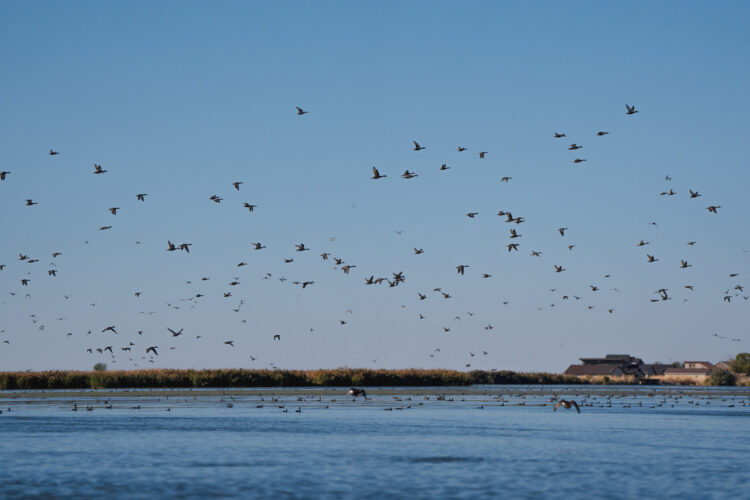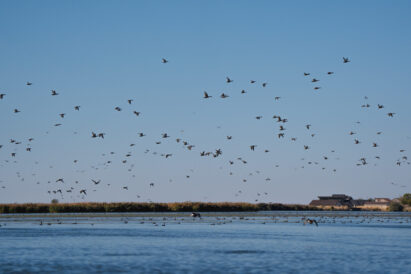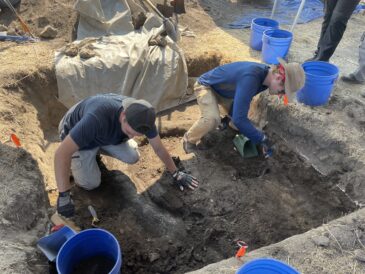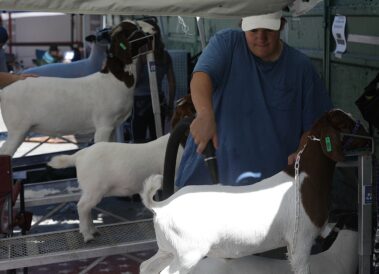As water levels dwindle, Utah legislature might address Great Salt Lake during a special session

Spenser Heaps for Utah News Dispatch
Birds take flight over the Great Salt Lake on Friday, Sept. 27, 2024.Utah House Speaker Mike Schultz said there will likely be a special session this fall that could address the Great Salt Lake, which has recently fallen to dangerously low levels.
Schultz told the Great Salt Lake Collaborative on Thursday he’s asking the Utah Division of Forestry, Fire and State Lands to reexamine how the berm that divides the north and south arms of the lake is managed — depending on what they find, Schultz said he might petition the governor to include Great Salt Lake legislation during a special session that will likely come in the fall.
“We think that could add some additional tools to the toolbox to help the ecosystem on the south arm,” said Schultz, R-Hooper.
The Great Salt Lake is currently at 4,192 feet in elevation, with the north arm at roughly 4,191.5 feet. That’s “scary low,” Great Salt Lake Commissioner Brian Steed said earlier this week, nearing levels not seen since the lake hit a historic low of 4,188.5 feet in fall 2022.
The berm that delineates the Great Salt Lake’s north and south arms is used to manage salinity, a critical measure of ecosystem health. The south arm is where the majority of fresh water flows to the lake, from the Bear, Weber and Jordan rivers — therefore, lake levels in the south arm are typically higher.
Now, the Utah Division of Forestry, Fire and State Lands, which manages much of the lake’s ecosystem, is going to see if it’s possible to raise the berm to 4,192 feet. That would cut off the north arm from fresh water inflows, increase levels on the south arm, and boost the south arm’s ecosystem.
Schultz said the north arm would not be permanently cut off, and that the state does not intend to kill one part of the lake to save another.
“At some point in time, that berm would get opened back up and the lake would be equalized so that we are not killing the north arm of the lake. That is not an option for us,” he said Thursday.
Currently, state code directs the division to close the berm if levels drop to 4,190 feet, a process that involves heavy machinery dumping boulders in the lake to form a closed causeway. Since the lake has not yet dropped that low, the berm is washed out and ineffective. If the division finds it feasible to raise the threshold to 4,192 feet, they would then close the berm. However, changing that threshold would require legislative approval, hence the special session.
Jamie Barnes, director of the Division of Forestry, Fire and State Lands, said the legislature could also amend state code so that changes to how the division manages the berm wouldn’t require a special session.
“Right now, we’re considering all options — what does it do for the ecosystem, what does it do for salinity, what does it do for the overall, whole area of the lake,” Barnes said.
As the lake shrinks, the lakebed is exposed, which contributes to poor air quality as storms whip up toxic, heavy metal-laden dust that blankets the Wasatch Front. That can cause respiratory problems and other health issues.
Declining levels can also expose microbialites, organic deposits that are a crucial part of the lake’s ecosystem. Microbialites are essential for brine fly populations, the main food source for millions of migratory birds that stop on the lake. If the microbialites are exposed for long periods of time, it can prompt a chain reaction ultimately impacting the entire ecosystem.
Less water in the lake also leads to an increase in salinity levels, which can harm the brine shrimp population — that can also have devastating impacts on the ecosystem, while hurting the million-dollar brine shrimp fishing industry.
Utah News Dispatch is part of States Newsroom, the nation’s largest state-focused nonprofit news organization.



